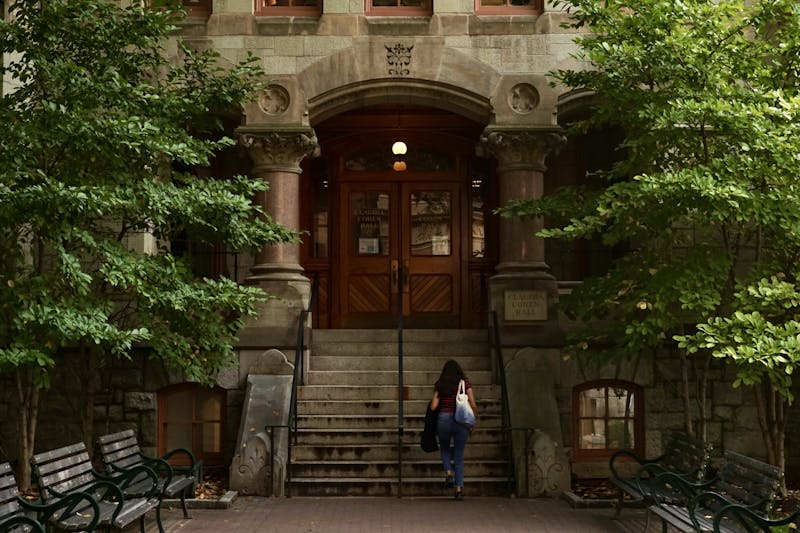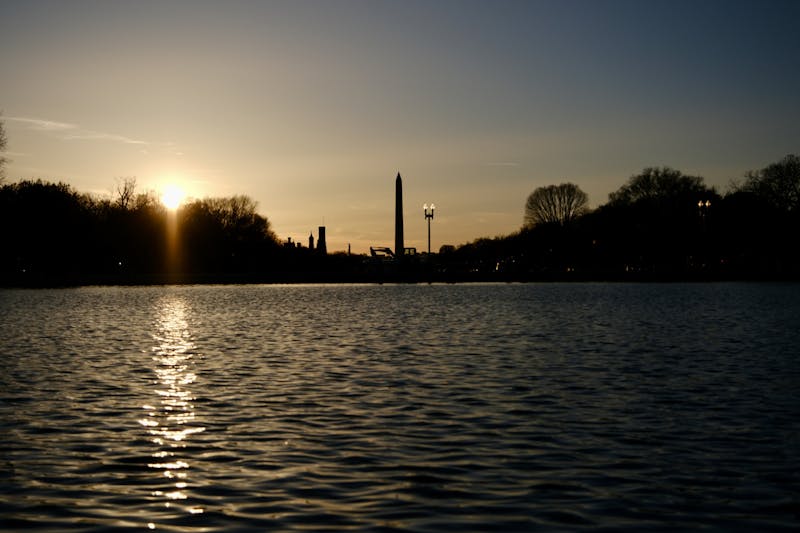
The first minority students to attend Penn were two Native American brothers of the Mohawk tribe who entered the Public Academy of Philadelphia in 1755. This was just 15 years after Benjamin Franklin founded the institution that would become the University of Pennsylvania in 1791. Ever since, race has been an issue that always looms large at Penn. But for almost two centuries it was one the University, like the rest of the nation, could easily brush aside.
| About this series Share your experiences Visit the entire series |
Beginnings
In 1879, the first African-American students enrolled at the University. Two years later, James Brister became Penn's first black graduate. The first black woman student, Elizabeth Bowser, entered the University in 1887, 11 years after the first white woman. From the late 1800s on, black students continued to attend Penn, but only in very limited numbers. And those that did attend were treated as second-class citizens despite their accomplishments. Many of the University's first African-American students rose to prominence at Penn and afterwards, especially as they broke color barriers. W.E.B. DuBois, one of this country's most prominent and influential black leaders, worked at the University from 1896 to 1897 as an assistant in the Sociology Department. Yet unlike his white colleagues, DuBois was only listed as a footnote in the College catalogue. Nothing really changed for 60 years. But beginning in the mid-1960s, race relations at Penn were transformed. With the rise of a national movement for civil rights, issues of racial equality gained prominence and urgency nationally and on campus. In response, University officials stepped up the minority recruitment effort, and focused in particular on recruiting more African-American students. From 1965 to 1969, the percentage of black students in the freshman class jumped from less than one to eight. The sense of racial volatility increased along with the number of African-American students. Many of the students Penn recruited came from poor, urban backgrounds. And the University had no support structure in place to help them. "The University didn't really make any accommodations for these new people they were bringing into the University," said History Professor Robert Engs, who is African American and came to Penn as a professor in 1972. "And as a result, [these students] felt alienated." African-American students sought to create their own tight-knit, supportive community and began advocating a message of separatism that was very much in keeping with the Black Power movement of the time. Slowly, black students got the school to create programs that better met their needs. In 1967, the Society of Afro-American Students was founded as a unifying organization for black students, and two years later, it moved to a social center called House of the Family, which excluded white students. And in 1970, the Afro-American Studies Program was approved, following three years of debate. Two years later saw the opening of DuBois College House, which is geared toward meeting the residential needs of black students. Political Action
With an administration that African Americans believed was frequently ignoring them, students turned to protests to make sure their concerns were addressed. "The strategies those students used were effective for that time," Engs said. The strategy? When all else fails, be dramatic. In 1970, black students burned a Penn administrator in effigy over budgetary disputes. Shortly thereafter, officials met with the students, smoothed out their financial disputes and agreed to increase minority recruitment efforts. In the same year, a dean who worked mainly with black students fought to improve minority student life. But Associate Dean of Students Doughtry Long resigned in frustration after trying to create a new advising system for black students. That was hardly the end, though. Students held a demonstration followed by days of protests. Ten days later, Long was arrested in connection with acts of arson in College Hall.
Furthering diversity
While much of Penn's chronicled history on race relations focuses on the integration of black students, the Latino and Asian-American communities have also been developing for decades. These groups definitely have a history at Penn. But it is often overlooked, because it is more recent and less turbulent -- and race issues are often perceived as being black and white. Joseph Sun, an Asian American who directs academic affairs in the Engineering School, noted that concepts of diversity and minority relations had a narrower focus in the past. "Since the very early days, race has been defined as a black and white discussion," he said. In 1972, five Latino students entered Penn and may have been the first to do so. And in 1973, El Movimiento Estudiantil Chicano de Azatlan, a club for Latino students of Mexican descent, was formed -- a group that still thrives on campus today. Numbers are improving slowly for Latino students on campus. There were 159 Latino undergraduates in 1977, but today there are 519. Beginning in the mid-1970s, the Asian-American student population rapidly began to rise. Between 1974 and 1977, the number of Asian-American students jumped from 20 to 120. That jump came after the U.S. relaxed immigration controls against Asians, resulting in a boom of immigration. At about the same time, Penn was beginning to expand its recruitment efforts across the nation.
Recent history
The University continued the struggle with racism in its own community during the 1980s. In 1981, DuBois was evacuated because of a bomb threat after a series of harassing phone calls. Nearly 1,000 students, faculty and staff rallied together to show their support for DuBois and to condemn racism. They linked arms, encircled the building and sang "We Shall Overcome." The University later came under fire for its lack of minority faculty and its low minority student retention rate, which are all issues that still plague Penn today. And then came the turbulent year of 1993, which saw Penn become the poster child for political correctness gone awry. "I wish it never came up," Sun said. "It's divisive. It's useless." Penn became a national target for PC backlash in 1993 with the infamous Water Buffalo incident. In January of that year, a student shouted, "Shut up, you water buffalo" out of a High Rise East window to black sisters of the Delta Sigma Theta sorority. He was charged with violating Penn's controversial racial harassment code. The five women later dropped the charges because they felt they couldn't get a fair trial. But the issue did not end there, as debates about the University's racial harassment policy raged. The policy was the brainchild of then-University President Sheldon Hackney, who was on his way out of Penn to become the chairman of the National Endowment for the Humanities. His newfound national stature made the policy and the University even more of a target. History Professor Alan Kors became deeply involved in the Water Buffalo case as the main advocate of the student charged with the violation, Eden Jacobowitz, and argued against the racial harassment policy. "The real issue... was the absurdity of the charges against the accused student. It was never an issue of race," he said. "Black students didn't think that any crisis had occurred." Just months later, a group identifying themselves as the "black community" seized an entire day's press run of The Daily Pennsylvanian in response to a conservative columnist they found offensive. Hackney did not punish the students involved in the theft, which prompted even more national outrage over what many considered to be a lax attitude regarding the First Amendment.
Today
Diversity has improved on campus over the years, but students and administrators alike agree that Penn is not where it needs to be. With the recent openings of La Casa Latina and the Pan-Asian American Community House, minority groups have gained new support from the administration, but many say it has created more divisions between racial groups. And political coalitions are in place to advocate for every major minority group. While all agree that recruitment and retention of minority students and faculty needs improvement, Penn is trying to improve in these areas. "I would say there's a very progressive attitude in College Hall about minority students and minority faculty," Beavers said. Still, race remains a complex issue and institutional change moves slowly. "It's very easy to complain," Engs said. "But it is truly remarkable, if I look back to 1972, the amount of change."
The Daily Pennsylvanian is an independent, student-run newspaper. Please consider making a donation to support the coverage that shapes the University. Your generosity ensures a future of strong journalism at Penn.
DonatePlease note All comments are eligible for publication in The Daily Pennsylvanian.







